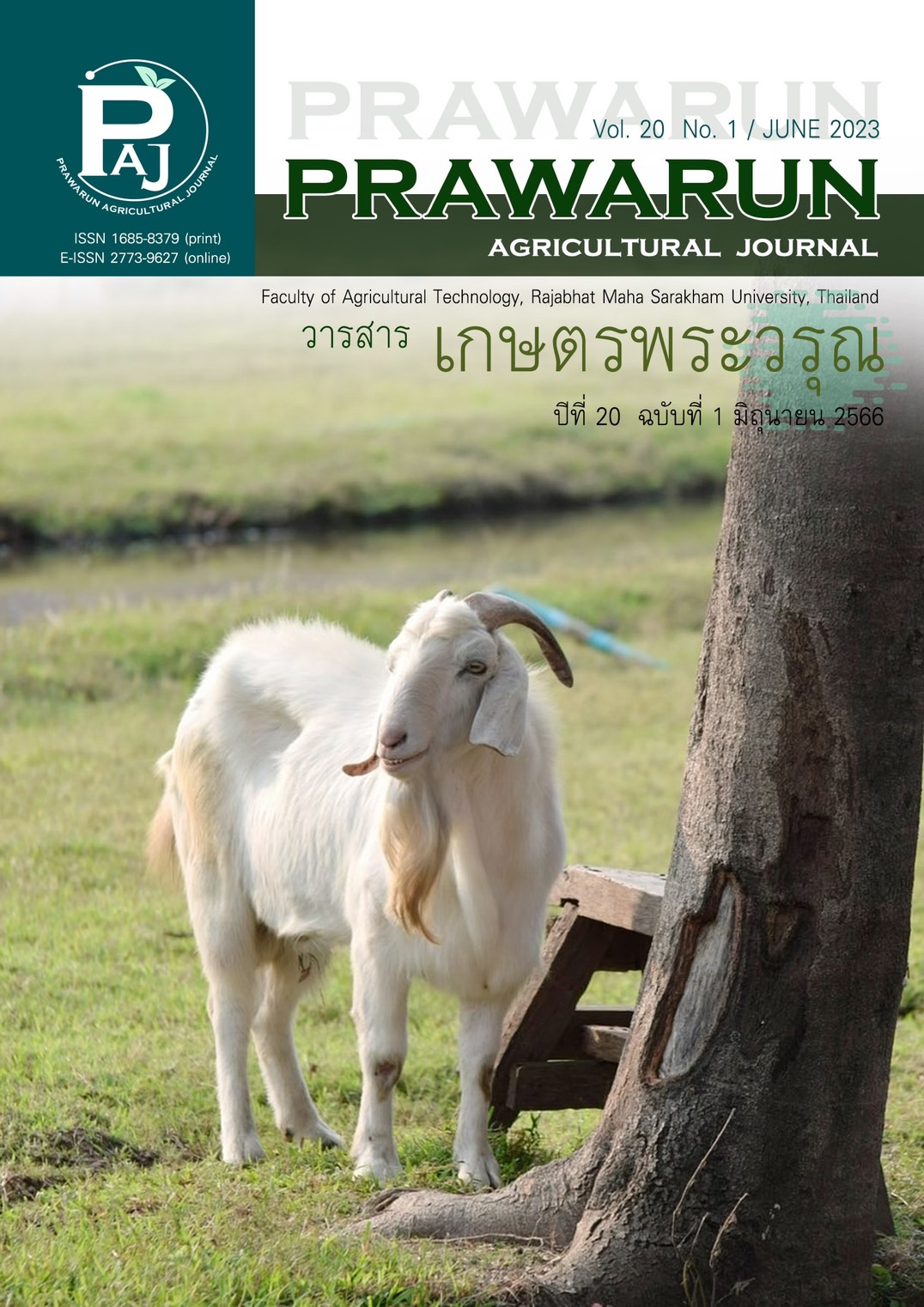ปริมาณสารไฟโตสเตอรอลและสารออกฤทธิ์ทางชีวภาพของข้าวบางสายพันธุ์
Main Article Content
บทคัดย่อ
งานวิจัยครั้งนี้มีวัตถุประสงค์เพื่อศึกษาปริมาณสารไฟโตสเตอรอลและสารออกฤทธิ์ทางชีวภาพ และกิจกรรมการต้านอนุมูลอิสระในข้าวบางสายพันธุ์ วางแผนการทดลองแบบสุ่มสมบูรณ์ (completely randomized design; CRD) จำนวน 3 ซ้ำ ประกอบด้วยข้าว 6 พันธุ์ ได้แก่ พันธุ์โสมมาลี หอมพิมาย หอมใบเตย ไรซ์เบอร์รี่ นิลสุรินทร์ และทับทิมชุมแพ วิเคราะห์หาปริมาณไฟโตสเตอรอล วิตามินอี แอนโทไซยานิน สารประกอบฟีนอลิคทั้งหมด และกิจกรรมต้านอนุมูลอิสระโดยวิธี DPPH ในเมล็ดข้าวกล้องทั้ง 6 พันธุ์ จากการศึกษาพบว่าข้าวต่างสายพันธุ์กันมีปริมาณสารไฟโตสเตอรอล วิตามินอี แอนโทไซยานิน สารประกอบฟีนอลิก และกิจกรรมการต้านอนุมูลอิสระแตกต่างกันในทางสถิติอย่างมีนัยสำคัญยิ่ง สารไฟโตสเตอรอลส่วนใหญ่ที่พบอยู่ในรูปของ Campesterol, β-Sitosterol และ Stigmasterol (69.85, 14.53 และ 7.49 เปอร์เซ็นต์ ตามลำดับ) ข้าวพันธุ์โสมมาลี หอมพิมาย และหอมใบเตยมีปริมาณไฟโตสเตอรอลทั้งหมดสูงกว่าข้าวพันธุ์ทับทิมชุมแพ ไรซ์เบอรี่ และนิลสุรินทร์ วิตามินอีส่วนมากอยู่ในรูป γ-Tocotrienol มากที่สุด (62.19 เปอร์เซ็นต์) รองลงมา คือ α-Tocotrienol (28.63 เปอร์เซ็นต์) ในขณะที่วิตามินอีที่อยู่ในรูป α-Tocopherol, γ -Tocopherol, δ-Tocopherol และ β-Tocopherol พบในปริมาณต่ำซึ่งข้าวพันธุ์โสมมาลีมีปริมาณวิตามินอีทั้งหมดสูงกว่าข้าวพันธุ์อื่น ข้าวพันธุ์นิลสุรินทร์มีปริมาณสารแอนโทไซยานินสูงที่สุด รองลงมา คือ ไรซ์เบอรี่ และทับทิมชุมแพ ตามลำดับ ซึ่งมีค่าสูงกว่าข้าวพันธุ์หอมพิมาย โสมมาลี และหอมใบเตย ข้าวพันธุ์หอมใบเตยมีปริมาณสารประกอบฟีนอลิกทั้งหมดสูงที่สุด รองลงมาคือ พันธุ์หอมพิมาย และ โสมมาลี ตามลำดับ ข้าวพันธุ์ไรซ์เบอรี่มีกิจกรรมต้านอนุมูลอิสระสูงที่สุด รองลงมาคือ พันธุ์โสมมาลี หอมใบเตย นิลสุรินทร์ ทับทิมชุมแพ และ หอมพิมาย ตามลำดับ ข้าวพันธุ์ที่มีกิจกรรมการต้านอนุมูลอิสระสูงนั้นอาจเป็นผลเนื่องมาผลรวมของสารออกฤทธิ์ทางชีวภาพหลาย ๆ ชนิดรวมกัน ดังนั้น การเลือกบริโภคข้าวเพียงชนิดใดชนิดหนึ่ง อาจได้รับสารอาหารและสารที่ออกฤทธิ์ทางชีวภาพไม่เพียงพอ การบริโภคข้าวเพื่อสุขภาพ หรือรับประทานข้าวเพื่อเป็นยา ควรเลือกบริโภคข้าวหลายชนิดร่วมกัน ซึ่งอาจจะนำข้าวกล้องที่มีสีเข้มมาผสมกับข้าวกล้องสีขาว เช่น ข้าวไรซ์เบอรี่ผสมกับข้าวโสมมาลี หรือผสมกับข้าวหอมใบเตย เป็นต้น
Article Details
เอกสารอ้างอิง
Abdel-Aal, E. S. M., & Hucl, P. (1999). A rapid method for quantifying total anthocyanins in blue aleurone and purple pericarp wheats. Cereal Chemistry,76(3),350-354.
Akinmoladun, A. C., Ibukun A., Afor, E., Obuotor, E. M., & Farombi, O. (2007). Phytochemical constituent and antioxidant activity of extract from the leaves of Ocimum gratissimum. Scientific Research and Essays, 2(5), 163-166.
Awad, A. B., & Fink, C. S. (2000). Phytosterols as anticancer dietary components: evidence and mechanism of action. The Journal of Nutrition, 130(9), 2127-2130.doi: 10.1093/jn/130.9.2127
Butsat, S., & Siriamornpun, S. (2010). Antioxidant capacities and phenolic compounds of the husk, bran and endosperm of Thai rice. Food Chemistry, 119(2), 606-613.
Debier, C., & Larondelle, Y. (2005). Vitamins A and E: metabolism, roles and transfer to offspring. British Journal of Nutrition, 93(2), 153–174. doi: 10.1079/bjn20041308.
Garcia, C. A., Gavino, G., Mosqueda, M. B., Hevia, P., & Gavino, V. C. (2007). Correlation of tocopherol, tocotrienol, γ-oryzanol and total polyphenol content in rice bran with different antioxidant capacity assays. Food Chemistry, 102(4), 1228-1232.
Lampi, A. M., Dimberg, L. H., & Kamal-Eldin, A. K. (1999). A study on the influence of fucosterol on thermal polymerisation of purified high oleic sunflower triacylglycerols. Journal of the Science of Food and Agriculture, 79(4), 573-579.
Loypimai, P., Moongngarm, A., & Chottanom, P. (2015). Impact of stabilization and extraction methods on chemical quality and bioactive compounds of rice bran oil. Emirates Journal of Food and Agriculture, 27(11), 849–856. doi: 10.9755/ejfa.2015.09.738
Marangoni, F., & Poli, A. (2010). Phytosterols and cardiovascular health. Pharmacological Research, 61(3), 193-199. doi: 10.1016/j.phrs.2010.01.001
Moreau, R. A., Whitaker, B. D., & Hicks, K. B. (2002). Phytosterols, phytostanols, and their conjugates in foods: structural diversity, quantitative analysis, and health-promoting uses. Progress in Lipid Research, 41(6), 457-500. doi: 10.1016/s0163-7827(02)00006-1
Noreen, H., Semmar, N., Farman, M., & McCullagh, J. S. O. (2017). Measurement of total phenolic content and antioxidant activity of aerial parts of medicinal plant Coronopus didymus. Asian Pacific Journal of Tropical Medicine, 10(8), 792–801.
Nystrom, L., Achrenius, T., Lampi, A. M., Moreau, R. A., & Piironen, V. (2007). A comparison of the antioxidant properties of steryl ferulates with tocopherol at high temperatures. Food Chemistry, 101(3), 947-954.
Ostlund, R. E. (2002). Phytosterols in human nutrition. Annual Review of Nutrition, 22(1), 533-549. doi: 10.1146/annurev.nutr.22.020702.075220
Rice Family Thailand (2023). High nutrious rice. Accessed May 9, 2023. Retrieved from https://www.thairicedb.com/rice.php?cid=6 (in Thai)
Shen, Y., Jin, l., Xiao, P., Lu, Y., & Bao, J. (2009). Total phenolics, flavonoids, antioxidant capacity in rice grain and their relations to grain color, size and weight. Journal of Cereal Science, 49(1), 106-111. doi:10.1016/j.jcs.2008.07.010
Sompong, R., Siebenhandl-Ehn, S., Linsberger-Martin, G., & Berghofer, E. (2011). Physicochemical and antioxidative properties of red and black rice varieties from Thailand, China and Sri Lanka. Food Chemistry, 124(1), 132–140. doi:10.1016/j.foodchem.2010.05.115
Tapiero, H., Townsend, D. M., & Tew, K. D. (2003). Phytosterols in the prevention of human pathologies. Biomed Pharmacother, 57(8), 321-325. doi: 10.1016/s0753-3322(03)00104-5
Thammapat, P., Meeso, N., & Siriamornpun, S. (2016). Effects of the traditional method and an alternative parboiling process on the fatty acids, vitamin E, γ-oryzanol and phenolic acids of glutinous rice. Food Chemistry, 194, 230–236. doi: 10.1016/j.foodchem.2015.08.014
Van Hoed, V., Depaemelaere, G., Ayala, J. V., Santiwattana, P., Verhe, R., & De Greyt, W. (2006). Influence of chemical refining on the major and minor components of rice bran oil. Journal of the American Oil Chemists' Society, 83, 315-321.
Vichapong, J., Sookserm, M., Srijesdaruk, V., Swatsitang, P., & Srijaranai, S. (2010). High performance liquid chromatographic analysis of phenolic compounds and their antioxidant activities in rice varieties. LWT-Food Science and Technology, 43(9), 1325-1330.
Walter, M., Marchesan, E., Massoni, P. F. S., da Silva, L. P., Sartori, G. M. S., & Ferreira, R. B. (2013). Antioxidant properties of rice grains with light brown, red and black pericarp colors and the effect of processing. Food Research International, 50(2), 698-703
Wang, Q., Han, P., Zhang, M., Xia, M., Zhu, H., Ma, J., Hou, M., Tang, Z., & Ling, W. (2007). Supplementation of black rice pigment fraction improves antioxidant and anti-inflammatory status in patients with coronary heart disease. Asia Pacific Journal of Clinical Nutrition 16(Suppl. 1), 295-301.
Yim, J. H., Seon, J. K., Song, E. K., Choi, J. I., Kim, M. C., Lee, K. B., & Seo, H. Y. (2013). A comparative study of meniscectomy and nonoperative treatment for degenerative horizontal tears of the medial meniscus. The American Journal of Sports Medicine, 41(7), 1565-1570. doi: 10.1177/0363546513488518
Yoshida, Y., Saito, Y., Jones, L. R., & Shigeri, Y. (2007). Chemical reactivities and physical effects in comparison between tocopherols and tocotrienols: physiological significance and prospects as antioxidant. Journal of Biosciences and Bioengineering, 104(6), 439-445


